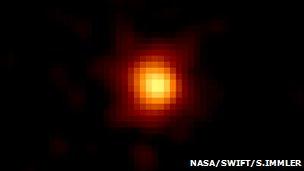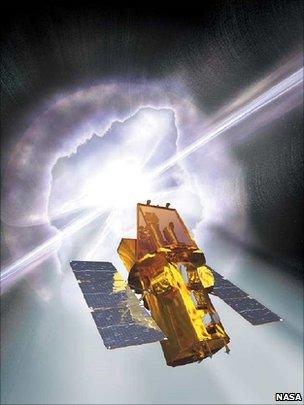Cosmic distance record 'broken'
- Published

The blast may have occurred a mere 520 million years after the Big Bang
A cataclysmic explosion of a huge star near the edge of the observable Universe may be the most distant single object yet spied by a telescope.
Scientists believe the blast, which was detected by Nasa's Swift space observatory, occurred a mere 520 million years after the Big Bang.
This means its light has taken a staggering 13.14 billion years to reach Earth.
Details of the discovery will appear shortly in the Astrophysical Journal.
The event, which was picked up by Swift in April 2009, is referred to by astronomers using the designation GRB 090429B.
The "GRB" stands for "gamma-ray burst" - a sudden pulse of very high-energy light that the telescope is tuned to find on the sky.
These bursts are usually associated with extremely violent processes, such as the end-of-life collapse of giant stars.
"It would have been a huge star, perhaps 30 times the mass of our Sun," said lead researcher Dr Antonino Cucchiara from the University of California, Berkeley.
"We do not have enough information to claim this was one of the so-called 'Population III" stars, which are the very first generation of stars in the Universe. But certainly we are in the earliest phases of star formation," he told BBC News.
Swift, as its name implies, has to act quickly to catch gamma-ray flashes because they will register for only a few minutes.
Record breaker
Fortunately, an afterglow at longer wavelengths will persist sometimes for days, which allows follow-up observations by other telescopes that can then determine distance.
It was this afterglow analysis that established another burst in the week previous to GRB 090429B to be at a separation from Earth of 13.04 billion light-years, making it temporarily the "most distant object in the Universe".

The event was picked up in April 2009 by Nasa's Swift telescope
This other event (GRB 090423) was reported fairly soon after its occurrence, but it has taken astronomers two years to come back with a confident assessment that an even greater expanse lies between Earth and GRB 090429B.
There are other competing candidates for the title of "most distant object". Hubble, for example, was given much more powerful instruments during its final astronaut servicing mission in 2009, and teams working on new images from the famous space telescope have seen galaxies that look not far short of GRB 090429B - and potentially even further out.
It should be stated, of course, that in these sorts of observations, there is always a degree of uncertainty.
Hubble's targets were galaxies - collections of stars; and GRB 090429B is the signature of a single event, a single star. So, in that sense, it might be considered apart.
Scientists are very keen to probe these great distances because they will learn how the early Universe evolved, and that will help them explain why the cosmos looks the way it does now.
They are particularly keen to trace the very first populations of stars. These hot, blue giants would have grown out of the cold neutral gas that pervaded the young cosmos.
Brilliant but brief
These behemoths would have burnt brilliant but brief lives, producing the very first heavy elements.
Their intense ultra-violet light would also have "fried" the neutral gas around them - ripping electrons off atoms - to produce the diffuse intergalactic plasma we still detect between nearby stars today.
So, apart from its status as a potential record-breaker, GRB 090429B is of intense interest because it is embedded directly in this time period - the "epoch of re-ionisation", as astronomers call it.
Whether GRB 090429B was one of the very first stars to shine in the Universe is doubtful, as Dr Cucchiara states. There may be several generations before it.
But Swift will keep looking, and it is ideally suited for the purpose, explains co-researcher Dr Paul O'Brien from the University of Leicester, UK.
"By finding the most distant objects we get an estimate, of course, of when the first objects formed," he told BBC News. "But then if you can find a location on the sky - in this case of a single star - you can go and look for the galaxy this object is presumably in, and you can start to study the very first galaxies.
"Because gamma-rays can get right through dust, this gives you a good, unbiased way of finding those first galaxies. One could just find very bright galaxies, whereas Swift means we can find the smaller galaxies, too. It was all of these objects that grew up to form the Universe we see around us today. If you think in terms of a human lifespan, it's about understanding what the Universe was like as a toddler."
The Swift mission was launched in 2004. It is a US space agency-managed venture but has a big UK and Italian contribution.
Britain's major input has been to provide an X-ray camera and the satellite's Ultraviolet/Optical Telescope.

Observations made at longer wavelengths - as in this infrared image of GRB 090429B taken by the Gemini North Telescope - are used to work out the distance
- Published20 October 2010